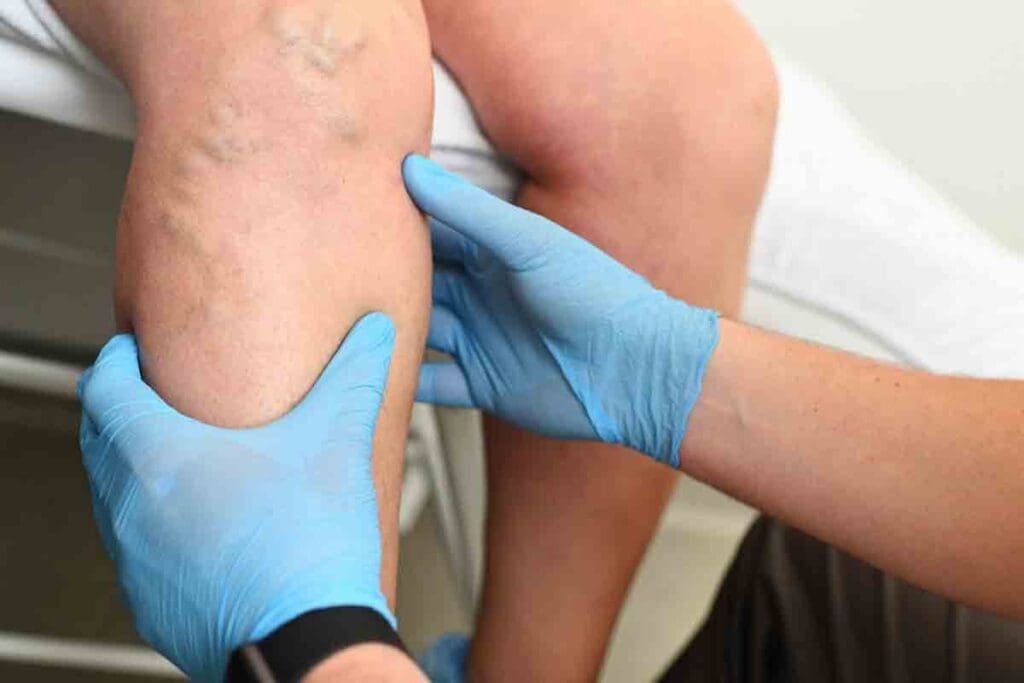Last Updated on November 17, 2025 by Ugurkan Demir

Deep vein thrombosis (DVT) is a serious condition where a blood clot forms in a deep vein. This usually happens in the lower leg, thigh, or pelvis. It’s important to recognize the early signs of a blood clot in your leg to avoid serious problems.
At LivHospital, we stress the need to know about DVT symptoms. Look out for sudden pain or cramping in the calf or thigh. Also, watch for swelling, warmth, and visible redness or discoloration. Sometimes, swollen veins can feel hard when touched.
If you notice any of these alarming signs, you must seek medical help right away. Knowing about deep vein thrombosis pain location and other symptoms can save your health.

Deep Vein Thrombosis (DVT) is a serious condition where a blood clot forms in deep veins. It often happens in the legs or pelvis. This can cause swelling, pain, or skin color changes.
If the clot breaks loose, it can travel to the lungs. This is a life-threatening situation known as pulmonary embolism.
DVT is dangerous because it can lead to severe complications. The biggest worry is that the clot can move to the lungs. This is known as pulmonary embolism and needs quick medical help.
“The risk of pulmonary embolism is the most significant concern with DVT, making prompt diagnosis and treatment critical.”
Vascular Surgeon
A blood clot in deep veins can also damage the vein. This can lead to long-term problems like post-thrombotic syndrome.
Several factors can increase the risk of DVT. These include being immobile for a long time, recent surgery, cancer, and genetic conditions. Knowing these risk factors is key to preventing and catching DVT early.
| Risk Factor | Description |
| Prolonged Immobility | Long periods of inactivity, such as during long flights or bed rest, increase the risk of DVT. |
| Recent Surgery | Surgical procedures, specially those involving the hips, knees, or abdomen, can increase the risk of developing blood clots. |
| Cancer | Certain types of cancer and cancer treatments can increase the risk of DVT. |
Knowing these risk factors helps people take steps to prevent DVT. They should also seek medical help if they notice any symptoms.
DVT often develops silently, but there are key signs you should never ignore. Deep Vein Thrombosis can be asymptomatic in about half of the cases, making it challenging to diagnose without medical screening. When symptoms do occur, they can be indicative of a potentially life-threatening condition.
The silent nature of DVT means that many individuals may not realize they have developed a blood clot until severe complications arise. It’s important to be aware of the risk factors and monitor for any unusual changes in your legs. Some people may experience no symptoms at all, while others might have noticeable signs that should prompt immediate medical evaluation.

If you experience any of the following symptoms, it’s essential to seek medical attention immediately: leg pain or tenderness, swelling, redness or discoloration, and warmth in the affected area. These signs could indicate the presence of a blood clot that may dislodge and cause a pulmonary embolism, a potentially fatal condition.
| Symptom | Description | Action |
| Leg Pain or Tenderness | Pain or discomfort in the leg, often starting in the calf | Seek medical attention if pain is severe or persistent |
| Swelling | Swelling in one leg (rarely both legs) | Monitor and seek help if swelling is significant |
| Redness or Discoloration | Redness, warmth, or discoloration around the affected area | Immediate medical evaluation is necessary |
| Warmth | The affected area feels warmer than the surrounding areas | Seek immediate medical attention |
Understanding these symptoms and knowing when to seek help can significantly reduce the risk of severe complications from DVT. We recommend being vigilant about your body’s signals and not hesitating to consult healthcare professionals if you notice any unusual signs.
Pain or discomfort in the affected limb is a key sign of Deep Vein Thrombosis. This pain can show up in different ways. It’s important to know what to look for to spot DVT early.
Sudden pain in the calf or thigh is a big warning sign. This pain might feel like a pulled muscle but is often worse and lasts longer. It’s key to tell the difference between muscle strain and DVT pain, as DVT needs quick medical help.
When you feel sudden calf pain or thigh pain, you might think it’s from overdoing it. But if it’s DVT, rest and usual muscle soreness remedies won’t fix it. Instead, the pain might get worse over time.
Cramping in the leg that doesn’t go away with movement or stretching could mean a blood clot. These cramps are like intense muscle spasms and might be with swelling or redness.
Cramping from DVT is different from regular muscle cramps because it doesn’t go away and comes with other signs like swelling. If you keep getting these cramps, getting checked by a doctor is important to rule out DVT.
Knowing about pain and discomfort is key to spotting DVT symptoms early. By recognizing these signs and getting medical help fast, people can lower the risk of DVT complications.
A blood clot in the deep veins can cause noticeable changes in your leg. These changes can be seen, like swelling or skin discoloration, or felt, like warmth. Spotting these signs early is key for treating Deep Vein Thrombosis (DVT).
Swelling in one leg is a common sign of DVT. This swelling happens because the clot blocks blood flow, leading to fluid buildup. Swelling from DVT doesn’t go away with rest or elevation. If you see swelling in one leg, get medical help right away.
Skin discoloration or redness can also signal DVT. The area might look red or discolored because of inflammation from the clot. This redness can also feel warm or tender. It’s important to tell the difference from other causes of redness, as DVT needs special treatment.
The area with DVT might feel warmer than the rest of your leg or the other leg. This warmth comes from the inflammation caused by the clot. Noticing one leg is much warmer than the other could mean DVT. This, along with other symptoms, means you should see a doctor.
The changes you see and feel in your leg can be signs of DVT. If you or someone you know is showing these signs, it’s important to see a healthcare professional. They can diagnose and treat DVT properly.
Calf DVT can cause pain and discomfort that may be confused with a pulled muscle. But there are key differences to look out for. When a blood clot forms in the deep veins of the calf, it can lead to a range of symptoms that require prompt medical evaluation.
DVT in the calf can manifest with tenderness or pain in the affected area. Unlike a pulled muscle, DVT pain typically doesn’t improve with movement or rest. Instead, it may worsen over time if left untreated.
The symptoms of calf DVT can include:
Distinguishing between DVT and a pulled muscle can be challenging. Both conditions can cause pain and discomfort in the leg. But there are some key differences to look out for:
| Symptom | DVT | Pulled Muscle |
| Pain Characteristics | Persistent, may worsen over time | Typically improves with rest |
| Swelling | Common, often accompanied by warmth | May occur, but not always with warmth |
| Response to Movement | Pain may not improve or may worsen | Pain often improves with rest |
If you’re experiencing persistent calf pain or swelling, it’s essential to seek medical attention. Early diagnosis and treatment can significantly improve outcomes.
Thigh pain can be a sign of DVT in the upper leg. This condition is often missed until it gets worse. It’s important to know its signs and symptoms.
DVT in the thigh is different from lower leg DVT. The pain in the upper leg is deep and lasts a long time. It can also spread to other areas.
Key symptoms of thigh DVT include:
DVT can happen in both the upper and lower leg. But, the symptoms and how serious they are can differ. Knowing these differences is key for the right diagnosis and treatment.
| Symptom | Upper Leg DVT | Lower Leg DVT |
| Pain Location | Typically deep in the thigh | Often in the calf |
| Swelling | Can be more extensive, involving the entire leg | Usually localized to the calf or ankle |
| Severity | Can be more severe due to larger clot size | Can be less severe but just as serious |
As DVT gets worse, it’s key to spot the advanced signs. These signs show a serious risk. They can mean a life-threatening condition is developing.
Visible engorged veins are a sign of advanced DVT. These veins swell and feel tender. If you see this, get medical help fast.
The area might get hard due to DVT. This is called phlegmasia cerulea dolens. It makes the leg swell, hurt, and change color. A vascular specialist says, “This is a serious sign that needs quick medical check-up.”
Pulmonary embolism is a deadly DVT complication. It happens when a clot goes to the lungs. Symptoms include sudden breath trouble, chest pain, and coughing up blood. If you have these, get emergency medical help right away. Experts say, “Pulmonary embolism is a medical emergency that needs quick treatment to save lives.”
It’s vital to know these advanced DVT signs and get medical help fast. Early action can greatly improve outcomes and stop serious problems.
In certain situations, like after surgery or for people with specific risk factors, finding DVT early is key. We must watch closely to avoid serious problems.
Patients after surgery face a higher risk of DVT because they are often not moving much. We should look out for these signs:
Early detection is vital here. It helps stop the clot from moving and causing a pulmonary embolism.
Some people, like those with DVT history, obesity, or cancer, are more likely to get DVT. We need to keep a close eye on them for symptoms like:
| Risk Factor | Common DVT Symptoms |
| History of DVT | Leg pain, swelling |
| Obesity | Swollen legs, skin discoloration |
| Cancer | Unexplained leg pain, swelling |
Heightened awareness of these risk factors and symptoms can lead to timely intervention and better outcomes.
By knowing the signs of DVT in special cases, we can offer better care. This helps lower the risk of complications.
Knowing the signs of Deep Vein Thrombosis (DVT) is key to preventing and managing it. We’ve talked about the symptoms, like pain and changes in the leg. It’s vital to recognize these signs.
Acting against DVT means watching your health closely. If you notice any symptoms, get medical help right away. By spreading awareness, we can stop DVT and its dangers, like pulmonary embolism.
To prevent DVT, you need to be proactive. Learn about your risk factors and how to lower them. Take charge of your health by staying informed and talking to doctors if you’re worried about DVT.
A blood clot in the leg can cause swelling, redness, and warmth. The skin may turn discolored. In severe cases, you might see visible engorged veins.
Blood clots in the legs, known as Deep Vein Thrombosis (DVT), are very serious. If not treated, they can break loose and travel to the lungs. This can cause a pulmonary embolism, which is very dangerous.
Symptoms of a blood clot in the calf include sudden pain or tenderness. You might also see swelling, redness, and warmth. Some people feel a cramping sensation that doesn’t go away.
Some people feel a DVT as a painful or tender area in their leg. Others might not feel anything. It’s important to know the risk factors and watch for signs of DVT, even without symptoms.
After surgery, signs of DVT include swelling, pain, or tenderness in the leg. You might also see redness or discoloration, and warmth. Patients should watch closely for these symptoms.
To detect a blood clot in the leg, know the risk factors and watch for signs. Look for swelling, pain, redness, and warmth. If you see these, get medical help right away.
Symptoms of a blood clot in the thigh include pain or tenderness, swelling, and redness. The pain might spread out more than a calf DVT. Some people feel a cramping sensation.
To know if you have a blood clot in your upper leg, look for swelling, pain, or tenderness. Also, watch for redness or discoloration. If you see these, get medical help.
Signs of pulmonary embolism include sudden shortness of breath, chest pain, and coughing up blood. These symptoms need immediate medical attention, as they can be deadly.
Yes, some risk factors increase the chance of getting DVT. These include being immobile for a long time, having recent surgery, cancer, or certain medical conditions. Knowing these can help you take steps to prevent DVT and seek help if symptoms appear.
Subscribe to our e-newsletter to stay informed about the latest innovations in the world of health and exclusive offers!